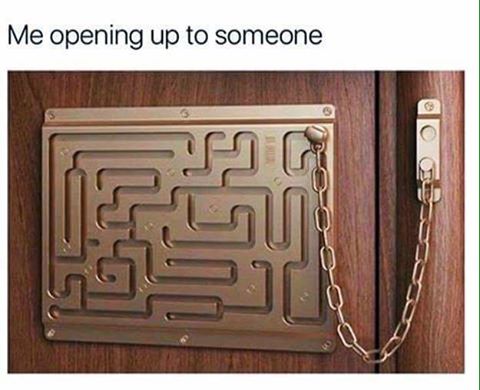One of the more maddening aspects of an illness (medical or mental health) is the unpredictable manner in which the ill person might respond to the problems brought on by their condition.
Irritability, secretiveness, the abandonment of important principles, perhaps intense excitement, enduring negativity, dangerous and other unexpected behaviors seem to take over the person’s overall personality. You wonder “How do we get the real person back, the one who used to be in this body?”
You and other people might feel desperate to break open that puzzling lock on the sufferer’s former self.
Yes, the overall problem can seem to resemble a puzzling lock. This picture that’s floating about the Internet symbolizes the problem rather well.
The too-common response to the phenomenon of puzzling behaviors is that observers, especially loved ones, try to change the puzzling, suffering person and their behaviors, hoping to make them “Well” again. They try to jam that release pin somewhere so that the lock can be forced open. None of their efforts seem to “work,” though.
Forcing change on someone is not a clever move. Even troubled minds want to make their own decisions.
The unhappily altered behaviors are symptoms of something causing them. The need to identify that cause is Priority One. Here’s why:
The affected person can’t simply “Change.” The decision-making process is not necessarily functioning for them. “Change” is not always possible when observers desire it to happen. Even compassion might not seem to help matters.
What can you do in the meantime?
Change your focus. Zero in on the thumbturn, the little item that releases the lock, opening access to a room, or in the case of a suffering person, their mind.
Go ahead, study the photograph above to understand my message. You need to change your response to the pin, not to focus on the body of the lock that holds those dead ends and perplexing turns.
Once you can release the pin holding things too close together for optimal health, you and the affected person have the opportunity to address why the pin/thumbturn was used in the first place.
What does the person want to protect him or herself from?
How can that fear or danger be better addressed so that the sufferer can be freed from a self-imposed or enforced prison?
What is or are the tool(s) for releasing the pin/thumbturn and freeing the malfunctioning prisoner?
A major tool for helping troubled people is compassion. Permit the suffering person to have their point of view instead of forcing it out of them.
Non-judgmental behavior is another tool. Do not criticize the person. Simply point out various aspects of their situation, what is and is not in their control. Speak of productive alternatives. Engage in discussions about the alternatives if possible.
Patience: Let the suffering person proceed at their own pace in 1) pondering troubling issues, 2) accessing the perspectives of other people involved and of the people who want to help them past the suffering.
The result can be that the sufferer will venture out of their prison (anger, fear, sadness, etc.) from time to time. It’s an experiment. They might indulge in counterproductive behaviors at times, and that’s something of a safety mechanism. Returning to familiar behaviors and thinking patterns is appealing for reasons too complicated to address in a blogpost. The suffering person needs to assess the effects of leaving unhappiness behind. Let them experiment with that, let them assess the results. Do what you can to keep them safe, but let them decide what they think and believe, and how they will behave. Do not dictate mindsets. Do not add insult to injury by criticizing the suffering person.
Do indicate that you want them to progress into healthy perspective. Praise every bit of progress, even if the person slips into negativity later. They’re going through a learning process. That means that they need time to adjust to a productive way of thinking and behaving, to make it habitual.
If the person simply has a personality trait, but not a personality disorder, that distresses you, perhaps you need to accept the fact that some people are legitimately, innately shy, private, wistful, gregarious or prone to thinking more than to behaving. Personality characteristics are not something to be dictated by others.
Mental health is one thing. The loss of contact with reality is quite another.
Personality differences are not a lack of mental health. Anti-social, dangerous behavior indicates the absence of mental health. That’s when mental health professionals are necessary, to intervene for the sake of public and private safety.
Are you dealing with a personality that you don’t understand? Look at the lock. Melt the pin with love and acceptance. It can help you, too, even if the situation is such that you need to call for professional help.

